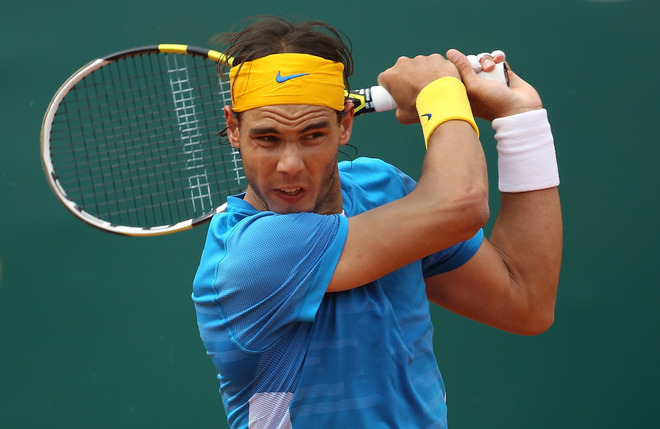By Charles Bricker
What more fitting way Friday for Rafa Nadal to win for the 30th consecutive time at Monte Carlo — at 40-15 a flat dart of a serve to the far corner of the deuce court and Juan Carlos Ferrero’s weak return into the net.
Nadal’s serving gets short shrift stacked up alongside his heavy topspin forehand, his amazing defense and his high-intensity competitiveness, but it can’t be overlooked in the arsenal he’s depending on to take him back to the top of tennis.

It’s not a boomer. He seldom hits heavier than 120 mph. But after some down time the last year and a half, the accuracy is back and he’s added some important variety to his placements.
This 6-4, 6-2 victory over good friend Ferrero moved Nadal into the semifinals against David Ferrer and let it be said that no one appears good enough at this point to stand in his way.
That was far from Nadal’s finest tennis on display on this windy, drizzly day in Monte Carlo, but that’s not to suggest he was mediocre. There were enough scintillating shots off his forehand side, plus one deadly short-angled backhand cross-court late in the match to let you know that, if the conditions are better, he’s going to be just about impeccable.
On the down side, he committed more unforced errors than winners for the first time this week (16 to 17) and he was broken for the first time as Ferrero rallied from an early break down in the opening set to win three games in a row. But after a short delay and calmer winds Nadal took control.
I’ve chronicled in this space how much more confident he looks on serve, especially in the ad court, where he’s no longer just trying to curl the ball deep to the backhand side against righties. He’s coming down the line more and throwing in a few body shots, and, when opponents “cheat” over to cover the down-the-middle, it only makes that slice to the backhand side more effective.
That break by Ferrero in the opening set was his only break point. In two previous matches this week, against young Thiemo de Bakker and linebacker-sized Michael Berrer, Nadal had defended the only three break points against him in a couple of matches that never reached the one-hour mark.
But it’s one thing to run up some impressive numbers against de Bakker and Berrer. It’s quite another when you’re dealing with Ferrero, who has won Monte Carlo twice. Back from injury last year, Ferrero has slowly recovered from a plunge to No. 115 back to No. 16 this week and came into the Nadal match with a 19-5 record. No one would be astonished if he was top-10 by the first day at Roland Garros.
This would be Nadal’s first real test of the clay court season and, though his stroking could use a bit more consistency — not much, but a bit, to reach his French Open standard — his defense was, as usual, fantastic. And as this match wore on and Ferrero found it harder and harder to hit winners (he had just 14 total), he played with more and more risk and too often found himself wide or deep of the lines. Nadal does that to everyone.
For Nadal, this is going to be a most interesting clay court season. He has to find just the right balance between wanting to play as much as possible before Roland Garros and the lurking threat of more knee problems.
Right now, he couldn’t look fitter. But none of us look at him any longer in the way we did two years ago — as the indestructible youth. There have been enough glitches with those legs to leave you wondering when, not if, the next injury will occur.
Maybe the road bumps the last year and a half are over. Maybe the doctors and trainers have found the right path to keeping him on court. No one, including Nadal, knows at this point.
This is just his first clay court tournament of the long build-up to the French, but know this. He’s playing with supreme confidence and it’s good to see him back at that level.
Charles Bricker can be reached at nflwriterr@aol.com
